Leadership Reflection: Authentic Leadership Development Analysis
VerifiedAdded on 2020/04/29
|6
|1305
|74
Essay
AI Summary
This essay provides a reflection on authentic leadership development, defining authenticity as being true to oneself and in tune with one's basic nature. It explores the key components of authentic leadership, including positive psychological capital, positive morality, leader self-awareness, and self-regulation. The essay highlights how authentic leaders attract followers by leading by example and fostering self-awareness in followers. It also discusses the development of followers and the importance of organizational context in nurturing authentic relationships. Furthermore, the essay contrasts authentic leadership with other styles, such as transformational leadership, and acknowledges the limitations of the model in quantifying the leader's contribution to self and follower development. The author concludes by emphasizing the relational and dynamic nature of authentic leadership and its distinct differences from other leadership theories.
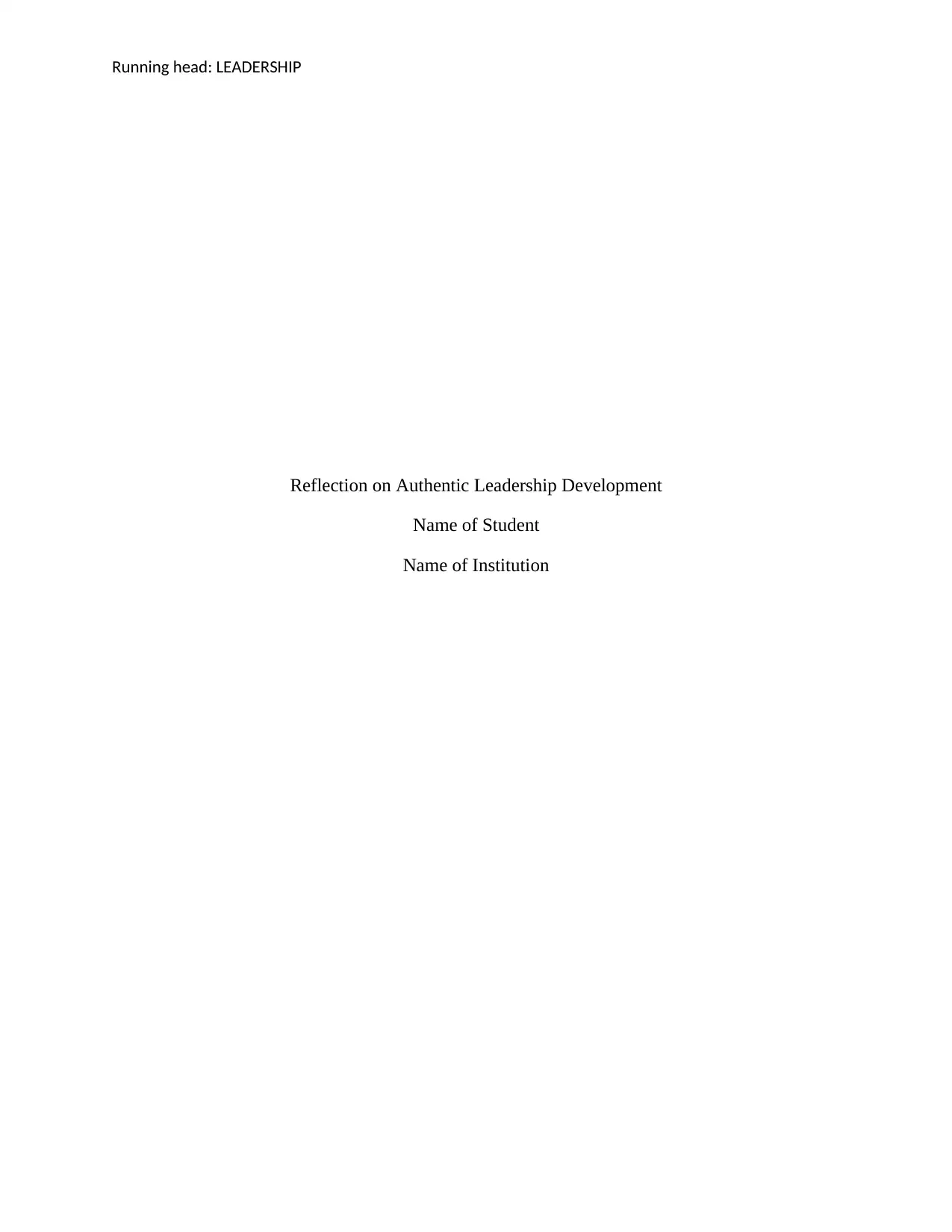
Running head: LEADERSHIP
Reflection on Authentic Leadership Development
Name of Student
Name of Institution
Reflection on Authentic Leadership Development
Name of Student
Name of Institution
Paraphrase This Document
Need a fresh take? Get an instant paraphrase of this document with our AI Paraphraser
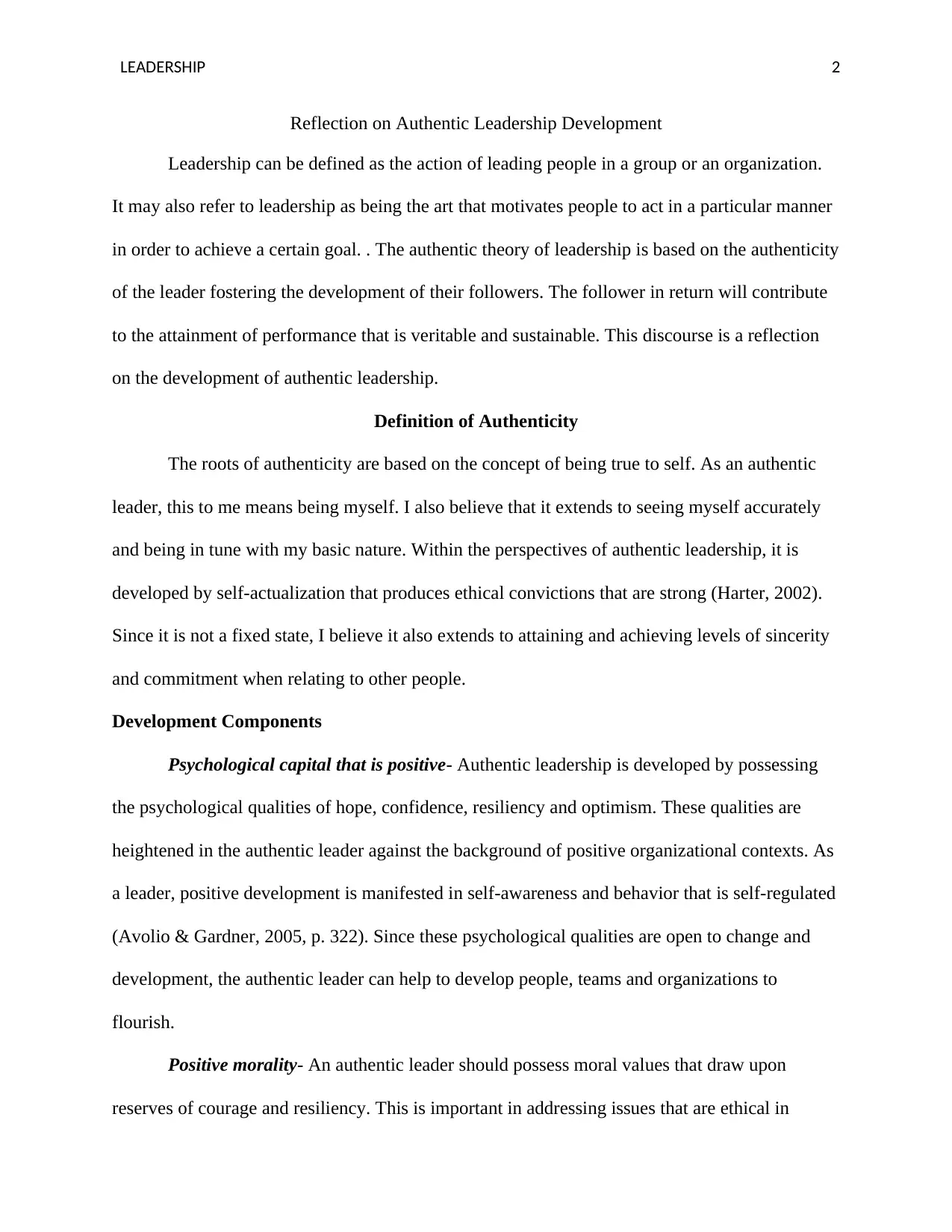
LEADERSHIP 2
Reflection on Authentic Leadership Development
Leadership can be defined as the action of leading people in a group or an organization.
It may also refer to leadership as being the art that motivates people to act in a particular manner
in order to achieve a certain goal. . The authentic theory of leadership is based on the authenticity
of the leader fostering the development of their followers. The follower in return will contribute
to the attainment of performance that is veritable and sustainable. This discourse is a reflection
on the development of authentic leadership.
Definition of Authenticity
The roots of authenticity are based on the concept of being true to self. As an authentic
leader, this to me means being myself. I also believe that it extends to seeing myself accurately
and being in tune with my basic nature. Within the perspectives of authentic leadership, it is
developed by self-actualization that produces ethical convictions that are strong (Harter, 2002).
Since it is not a fixed state, I believe it also extends to attaining and achieving levels of sincerity
and commitment when relating to other people.
Development Components
Psychological capital that is positive- Authentic leadership is developed by possessing
the psychological qualities of hope, confidence, resiliency and optimism. These qualities are
heightened in the authentic leader against the background of positive organizational contexts. As
a leader, positive development is manifested in self-awareness and behavior that is self-regulated
(Avolio & Gardner, 2005, p. 322). Since these psychological qualities are open to change and
development, the authentic leader can help to develop people, teams and organizations to
flourish.
Positive morality- An authentic leader should possess moral values that draw upon
reserves of courage and resiliency. This is important in addressing issues that are ethical in
Reflection on Authentic Leadership Development
Leadership can be defined as the action of leading people in a group or an organization.
It may also refer to leadership as being the art that motivates people to act in a particular manner
in order to achieve a certain goal. . The authentic theory of leadership is based on the authenticity
of the leader fostering the development of their followers. The follower in return will contribute
to the attainment of performance that is veritable and sustainable. This discourse is a reflection
on the development of authentic leadership.
Definition of Authenticity
The roots of authenticity are based on the concept of being true to self. As an authentic
leader, this to me means being myself. I also believe that it extends to seeing myself accurately
and being in tune with my basic nature. Within the perspectives of authentic leadership, it is
developed by self-actualization that produces ethical convictions that are strong (Harter, 2002).
Since it is not a fixed state, I believe it also extends to attaining and achieving levels of sincerity
and commitment when relating to other people.
Development Components
Psychological capital that is positive- Authentic leadership is developed by possessing
the psychological qualities of hope, confidence, resiliency and optimism. These qualities are
heightened in the authentic leader against the background of positive organizational contexts. As
a leader, positive development is manifested in self-awareness and behavior that is self-regulated
(Avolio & Gardner, 2005, p. 322). Since these psychological qualities are open to change and
development, the authentic leader can help to develop people, teams and organizations to
flourish.
Positive morality- An authentic leader should possess moral values that draw upon
reserves of courage and resiliency. This is important in addressing issues that are ethical in
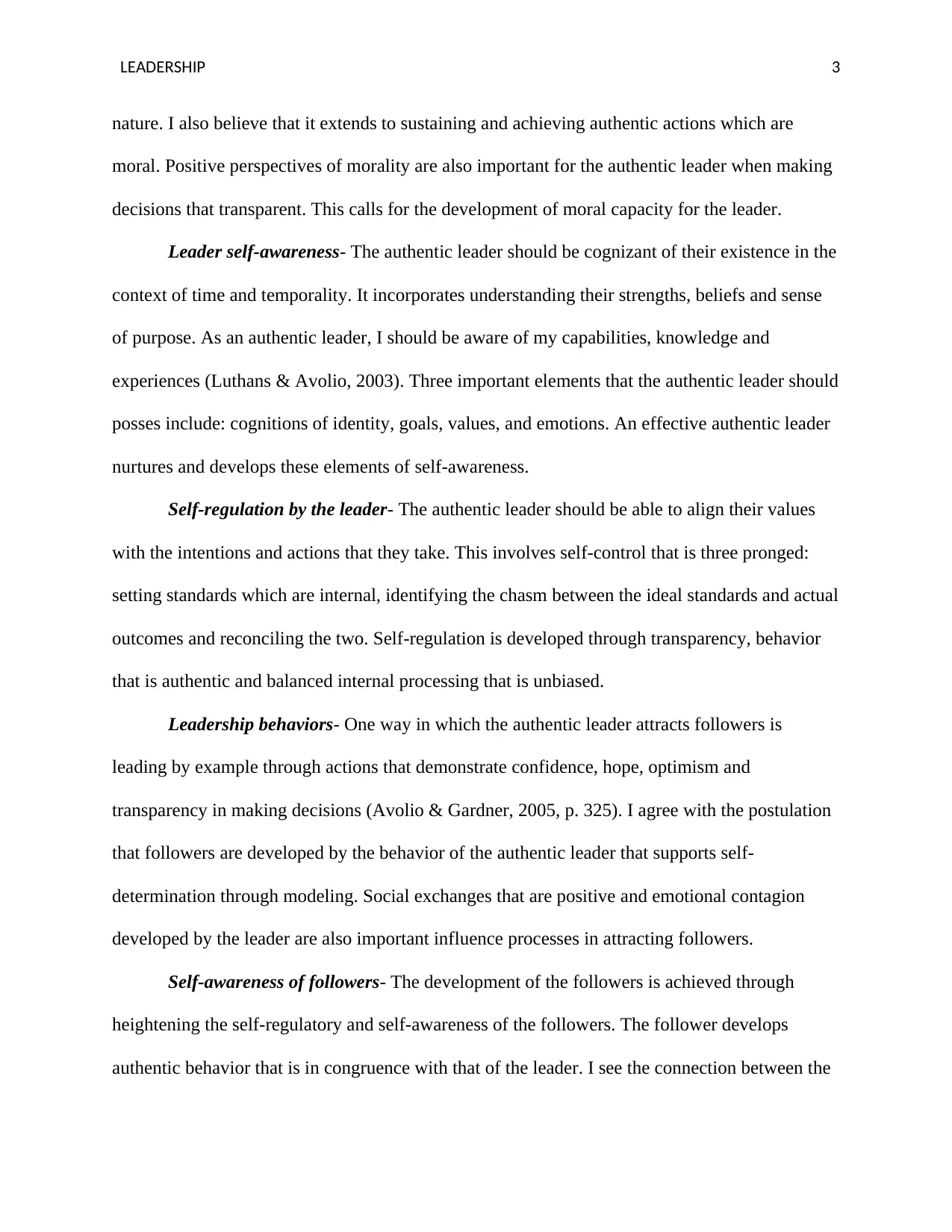
LEADERSHIP 3
nature. I also believe that it extends to sustaining and achieving authentic actions which are
moral. Positive perspectives of morality are also important for the authentic leader when making
decisions that transparent. This calls for the development of moral capacity for the leader.
Leader self-awareness- The authentic leader should be cognizant of their existence in the
context of time and temporality. It incorporates understanding their strengths, beliefs and sense
of purpose. As an authentic leader, I should be aware of my capabilities, knowledge and
experiences (Luthans & Avolio, 2003). Three important elements that the authentic leader should
posses include: cognitions of identity, goals, values, and emotions. An effective authentic leader
nurtures and develops these elements of self-awareness.
Self-regulation by the leader- The authentic leader should be able to align their values
with the intentions and actions that they take. This involves self-control that is three pronged:
setting standards which are internal, identifying the chasm between the ideal standards and actual
outcomes and reconciling the two. Self-regulation is developed through transparency, behavior
that is authentic and balanced internal processing that is unbiased.
Leadership behaviors- One way in which the authentic leader attracts followers is
leading by example through actions that demonstrate confidence, hope, optimism and
transparency in making decisions (Avolio & Gardner, 2005, p. 325). I agree with the postulation
that followers are developed by the behavior of the authentic leader that supports self-
determination through modeling. Social exchanges that are positive and emotional contagion
developed by the leader are also important influence processes in attracting followers.
Self-awareness of followers- The development of the followers is achieved through
heightening the self-regulatory and self-awareness of the followers. The follower develops
authentic behavior that is in congruence with that of the leader. I see the connection between the
nature. I also believe that it extends to sustaining and achieving authentic actions which are
moral. Positive perspectives of morality are also important for the authentic leader when making
decisions that transparent. This calls for the development of moral capacity for the leader.
Leader self-awareness- The authentic leader should be cognizant of their existence in the
context of time and temporality. It incorporates understanding their strengths, beliefs and sense
of purpose. As an authentic leader, I should be aware of my capabilities, knowledge and
experiences (Luthans & Avolio, 2003). Three important elements that the authentic leader should
posses include: cognitions of identity, goals, values, and emotions. An effective authentic leader
nurtures and develops these elements of self-awareness.
Self-regulation by the leader- The authentic leader should be able to align their values
with the intentions and actions that they take. This involves self-control that is three pronged:
setting standards which are internal, identifying the chasm between the ideal standards and actual
outcomes and reconciling the two. Self-regulation is developed through transparency, behavior
that is authentic and balanced internal processing that is unbiased.
Leadership behaviors- One way in which the authentic leader attracts followers is
leading by example through actions that demonstrate confidence, hope, optimism and
transparency in making decisions (Avolio & Gardner, 2005, p. 325). I agree with the postulation
that followers are developed by the behavior of the authentic leader that supports self-
determination through modeling. Social exchanges that are positive and emotional contagion
developed by the leader are also important influence processes in attracting followers.
Self-awareness of followers- The development of the followers is achieved through
heightening the self-regulatory and self-awareness of the followers. The follower develops
authentic behavior that is in congruence with that of the leader. I see the connection between the
⊘ This is a preview!⊘
Do you want full access?
Subscribe today to unlock all pages.

Trusted by 1+ million students worldwide
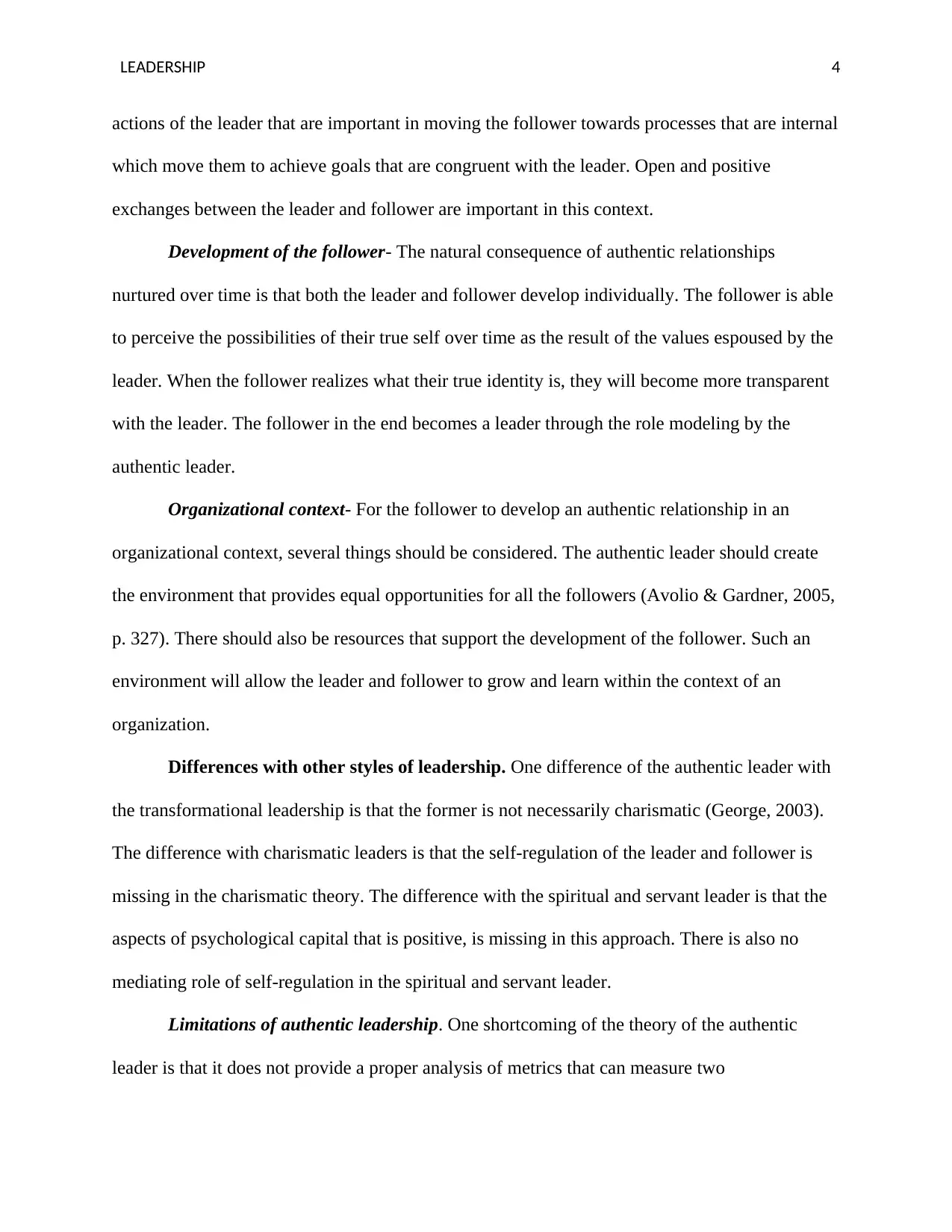
LEADERSHIP 4
actions of the leader that are important in moving the follower towards processes that are internal
which move them to achieve goals that are congruent with the leader. Open and positive
exchanges between the leader and follower are important in this context.
Development of the follower- The natural consequence of authentic relationships
nurtured over time is that both the leader and follower develop individually. The follower is able
to perceive the possibilities of their true self over time as the result of the values espoused by the
leader. When the follower realizes what their true identity is, they will become more transparent
with the leader. The follower in the end becomes a leader through the role modeling by the
authentic leader.
Organizational context- For the follower to develop an authentic relationship in an
organizational context, several things should be considered. The authentic leader should create
the environment that provides equal opportunities for all the followers (Avolio & Gardner, 2005,
p. 327). There should also be resources that support the development of the follower. Such an
environment will allow the leader and follower to grow and learn within the context of an
organization.
Differences with other styles of leadership. One difference of the authentic leader with
the transformational leadership is that the former is not necessarily charismatic (George, 2003).
The difference with charismatic leaders is that the self-regulation of the leader and follower is
missing in the charismatic theory. The difference with the spiritual and servant leader is that the
aspects of psychological capital that is positive, is missing in this approach. There is also no
mediating role of self-regulation in the spiritual and servant leader.
Limitations of authentic leadership. One shortcoming of the theory of the authentic
leader is that it does not provide a proper analysis of metrics that can measure two
actions of the leader that are important in moving the follower towards processes that are internal
which move them to achieve goals that are congruent with the leader. Open and positive
exchanges between the leader and follower are important in this context.
Development of the follower- The natural consequence of authentic relationships
nurtured over time is that both the leader and follower develop individually. The follower is able
to perceive the possibilities of their true self over time as the result of the values espoused by the
leader. When the follower realizes what their true identity is, they will become more transparent
with the leader. The follower in the end becomes a leader through the role modeling by the
authentic leader.
Organizational context- For the follower to develop an authentic relationship in an
organizational context, several things should be considered. The authentic leader should create
the environment that provides equal opportunities for all the followers (Avolio & Gardner, 2005,
p. 327). There should also be resources that support the development of the follower. Such an
environment will allow the leader and follower to grow and learn within the context of an
organization.
Differences with other styles of leadership. One difference of the authentic leader with
the transformational leadership is that the former is not necessarily charismatic (George, 2003).
The difference with charismatic leaders is that the self-regulation of the leader and follower is
missing in the charismatic theory. The difference with the spiritual and servant leader is that the
aspects of psychological capital that is positive, is missing in this approach. There is also no
mediating role of self-regulation in the spiritual and servant leader.
Limitations of authentic leadership. One shortcoming of the theory of the authentic
leader is that it does not provide a proper analysis of metrics that can measure two
Paraphrase This Document
Need a fresh take? Get an instant paraphrase of this document with our AI Paraphraser
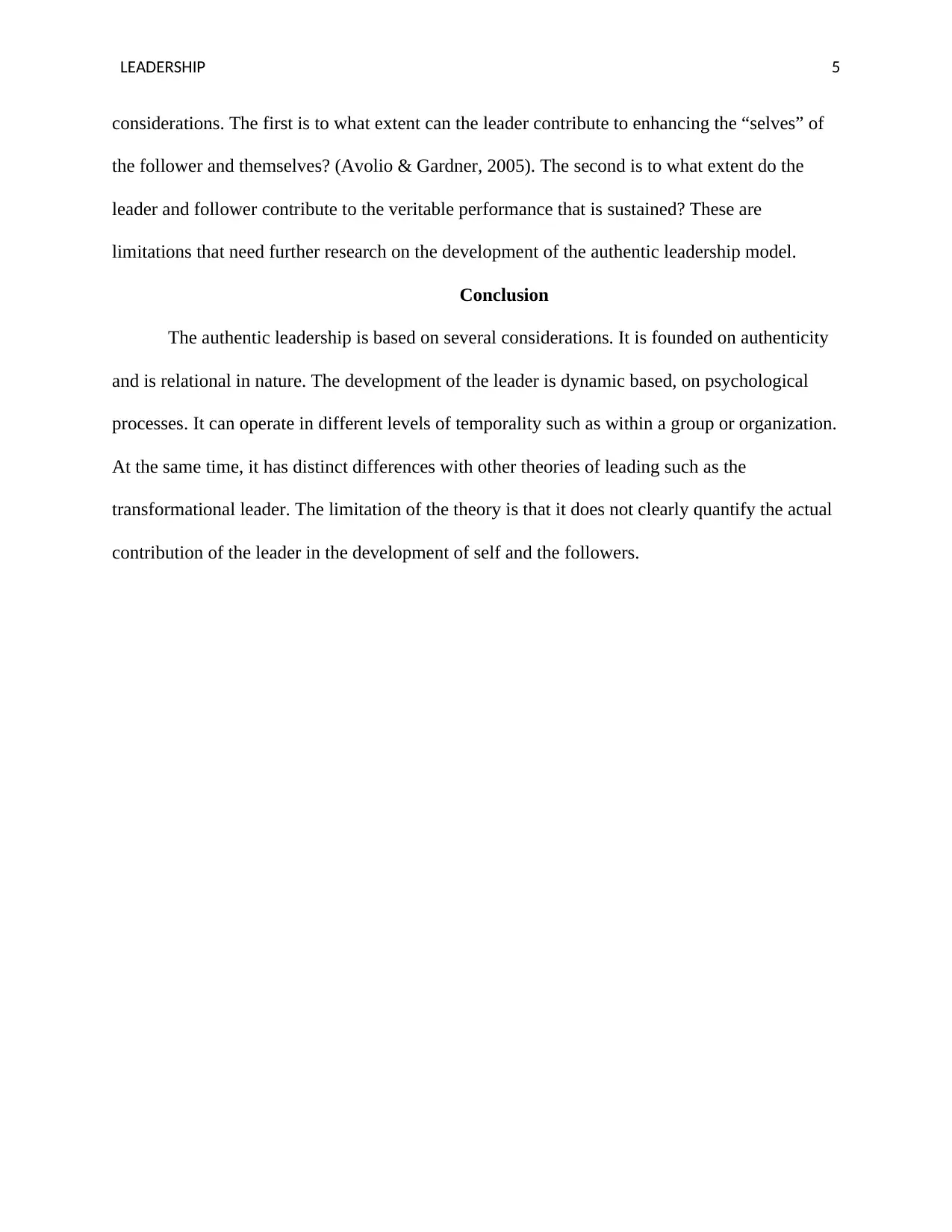
LEADERSHIP 5
considerations. The first is to what extent can the leader contribute to enhancing the “selves” of
the follower and themselves? (Avolio & Gardner, 2005). The second is to what extent do the
leader and follower contribute to the veritable performance that is sustained? These are
limitations that need further research on the development of the authentic leadership model.
Conclusion
The authentic leadership is based on several considerations. It is founded on authenticity
and is relational in nature. The development of the leader is dynamic based, on psychological
processes. It can operate in different levels of temporality such as within a group or organization.
At the same time, it has distinct differences with other theories of leading such as the
transformational leader. The limitation of the theory is that it does not clearly quantify the actual
contribution of the leader in the development of self and the followers.
considerations. The first is to what extent can the leader contribute to enhancing the “selves” of
the follower and themselves? (Avolio & Gardner, 2005). The second is to what extent do the
leader and follower contribute to the veritable performance that is sustained? These are
limitations that need further research on the development of the authentic leadership model.
Conclusion
The authentic leadership is based on several considerations. It is founded on authenticity
and is relational in nature. The development of the leader is dynamic based, on psychological
processes. It can operate in different levels of temporality such as within a group or organization.
At the same time, it has distinct differences with other theories of leading such as the
transformational leader. The limitation of the theory is that it does not clearly quantify the actual
contribution of the leader in the development of self and the followers.
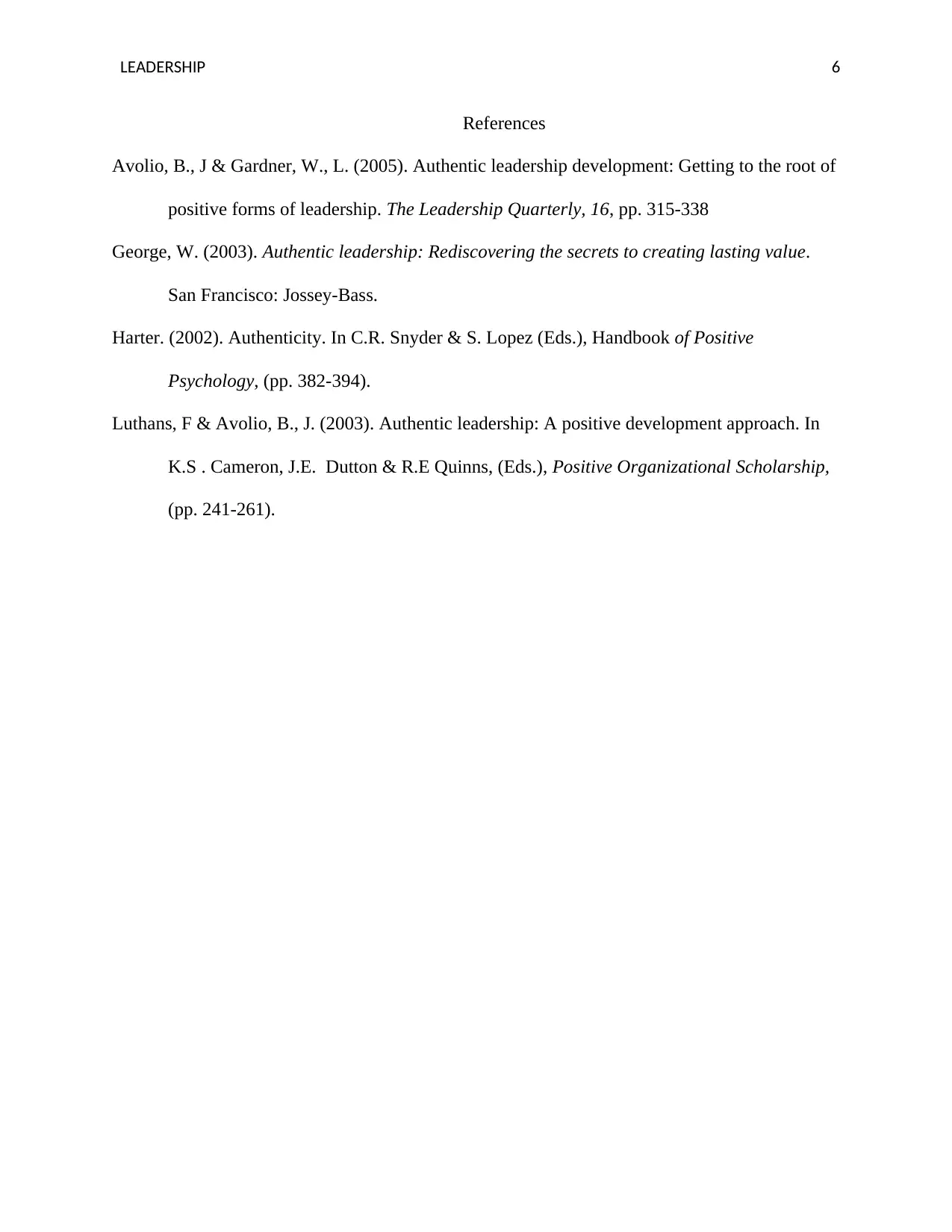
LEADERSHIP 6
References
Avolio, B., J & Gardner, W., L. (2005). Authentic leadership development: Getting to the root of
positive forms of leadership. The Leadership Quarterly, 16, pp. 315-338
George, W. (2003). Authentic leadership: Rediscovering the secrets to creating lasting value.
San Francisco: Jossey-Bass.
Harter. (2002). Authenticity. In C.R. Snyder & S. Lopez (Eds.), Handbook of Positive
Psychology, (pp. 382-394).
Luthans, F & Avolio, B., J. (2003). Authentic leadership: A positive development approach. In
K.S . Cameron, J.E. Dutton & R.E Quinns, (Eds.), Positive Organizational Scholarship,
(pp. 241-261).
References
Avolio, B., J & Gardner, W., L. (2005). Authentic leadership development: Getting to the root of
positive forms of leadership. The Leadership Quarterly, 16, pp. 315-338
George, W. (2003). Authentic leadership: Rediscovering the secrets to creating lasting value.
San Francisco: Jossey-Bass.
Harter. (2002). Authenticity. In C.R. Snyder & S. Lopez (Eds.), Handbook of Positive
Psychology, (pp. 382-394).
Luthans, F & Avolio, B., J. (2003). Authentic leadership: A positive development approach. In
K.S . Cameron, J.E. Dutton & R.E Quinns, (Eds.), Positive Organizational Scholarship,
(pp. 241-261).
⊘ This is a preview!⊘
Do you want full access?
Subscribe today to unlock all pages.

Trusted by 1+ million students worldwide
1 out of 6
Related Documents
Your All-in-One AI-Powered Toolkit for Academic Success.
+13062052269
info@desklib.com
Available 24*7 on WhatsApp / Email
![[object Object]](/_next/static/media/star-bottom.7253800d.svg)
Unlock your academic potential
Copyright © 2020–2025 A2Z Services. All Rights Reserved. Developed and managed by ZUCOL.





